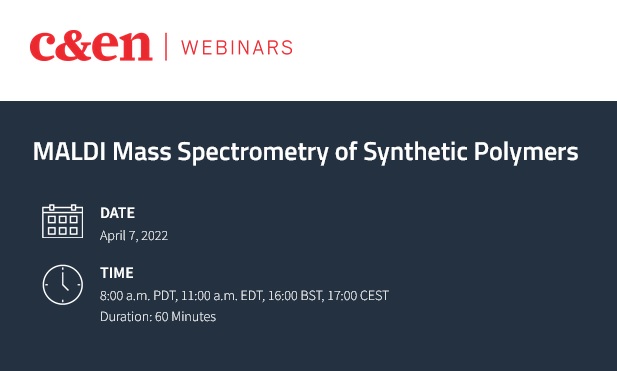MALDI Mass Spectrometry of Synthetic Polymers

C&EN: MALDI Mass Spectrometry of Synthetic Polymers
Matrix-Assisted Laser Desorption/Ionization Mass Spectrometry (MALDI-MS) provides a powerful and versatile method for the molecular characterization of synthetic macromolecules and polymeric materials as well as for imaging the composition and defects of solid polymer surfaces.
The dispersive nature, high mass resolution, and unparalleled sensitivity of MS permit the conclusive and confident elucidation of molecular weight (MW), functionality, and end group distributions and are particularly suitable for monitoring reactions that change the mass. This information is important for both structural identification as well as the determination of polymerization mechanisms. Unlike most other MS ionization methods, MALDI does not require sample solubility, substantially expanding the range of analyzable materials.
Furthermore, MALDI also allows for mass spectrometry imaging (MSI) studies to evaluate the spatial distribution of analytes or imaging defects on materials surfaces. These advantages are enhanced by MALDI tandem mass spectrometry (MS/MS), which can be applied on individual oligomers to establish their functional groups and branching architectures as well as, for copolymers, their comonomer sequences.
Key Learning Objectives:
- Learn how to utilize MALDI-MS for the precise structural analysis of a wide variety of synthetic materials and the elucidation of polymerization mechanisms
- Learn how to utilize MALDI-MS/MS for isomer differentiation and the determination of polymer sequences and architectures
- Learn how to utilize MALDI-MSI for identifying the spatial distributions of analytes or imaging of defects on polymer surfaces
Who Should Attend:
- Laboratory managers
- Polymer material scientists
- Product developers and managers
Presenter: Chrys Wesdemiotis (Professor of Chemistry and Polymer Science, University of Akron)
Presenter: Ann Thayer (Contributing Editor, C&EN Media Group)